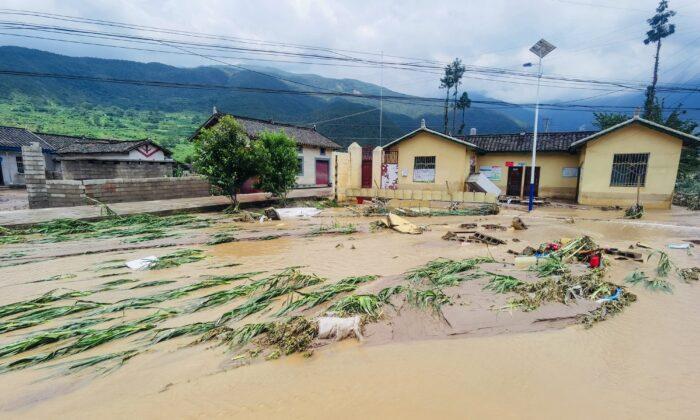Heavy rain continued to fall on dozens of Chinese cities on June 29, leading to severe flooding. But unlike past instances of major disasters, no senior Chinese Communist Party officials have visited the affected regions thus far.
Moreover, the Three Gorges Dam, located in the upper region of the Yangtze river in Hubei Province, and other reservoirs discharged their accumulated water, affecting nearby cities.
For example, in Wuhan, the capital city of Hubei and where the COVID-19 pandemic first broke out, floodwaters reached up to car roofs.
Weather forecasts showed that the Yangtze river region will experience more rainfall in the next ten days. Hydrologists have
previously warned that discharged water from the Three Gorges reservoir could sweep away people who live downstream.
Discharging Water
State-run media Xinhua
quoted government officials who confirmed that the Three Gorges Dam released the accumulated stormwater in its reservoir on June 29.
The discharging average speed on Monday was 35,000 cubic meters per second (about 554.76 million gallons per minute), according to the report.
The department of water resources of Hubei also
announced on June 29 that it discharged water from 1,081 local reservoirs after their water levels went over the warning limits.
The department added that eight of those reservoirs were large-size, meaning their storage capacities were larger than 100 million cubic meters (26.4 trillion gallons); 28 of them were medium-size, with storage capacities of more than 10 million cubic meters (2.6 trillion gallons); and 1,045 small-size.
Wuhan has the Yangtze river passing through it. The city was
inundated on June 29 due to the high water level of the Yangtze and heavy rain.
State-run media Hubei Jingshi
reported that floodwaters had entered the first floor of buildings in some neighborhoods of Wuhan. In addition, 35 roads in the Qiaokou, Wuchang, Hongshan, and Gaoxin districts were
closed on Monday due to the deep flood waters.
Many other cities in Hubei were also suffering from flooding.
State-run CCTV
reported that on June 27 evening in Guangshui city, flood waters reached so high that people could not get out of their cars or houses.
The regime has not announced any related death toll, but locals shared a video on social media of a woman who died after she was washed away by flood waters.
On June 27, the cities of
Yichang, Xiangyang, Jingmen, Xiaogan, Huanggang, Enshi, and Shennongjia
reported floods. 7,005 people were forced to leave their homes and about 650,000 others suffered losses due to the flooding, according to authorities.
The central government
announced on Monday that more heavy rainstorms are forecasted to arrive in the upper regions of the Three Gorges Dam during the first half of July.
In the early hours of June 30, Xinyang city in Henan Province, Shijiazhuang city in Hebei Province, Hengdong county in Hunan Province, and other regions also reported flooding.
Chinese Leaders
26 out of China’s 34 provinces and regions have reported flooding in June. But no Chinese senior officials have visited the disaster areas.In past decades, officials would visit as part of the Party’s propaganda efforts. Premier Li Keqiang, and former premiers Wen Jiabao and Zhu Rongji visited Wuhan during the flooding season in 2016, 2010, and 1998.
On June 27, some state-run media
published reports that Wen met with the director of the Earth Sciences School of Lanzhou University in Beijing on June 22. Since October 2019, he hadn’t participated in any public activities.
The timing and location—the school is known for its hydraulic engineering program—has China observers speculating that Wen’s recent appearance is not coincidental.
“He wants to deliver the message that he is focusing on the Three Gorges Dam,” said U.S.-based China affairs commentator Tang Jingyuan in an interview.
Before his political career,
Wen was a geologist and engineer for 17 years, upon graduating with a master’s in geology.
When he was premier, Wen did not show public support for the Three Gorges Dam. When the dam’s completion ceremony was held in May 2006, neither Wen nor Hu Jintao—then-Chinese leader and former hydraulic engineer—attended.
Meanwhile, current Party leaders have not addressed the nationwide disaster.
On June 29, Chinese leader Xi Jinping
hosted a politburo meeting in Beijing. He made no mention of the flooding but said: “The army must unswervingly adhere to the party’s absolute leadership… The military must be absolutely loyal, absolutely pure, and absolutely reliable.”
This is his first public appearance since
Xi attended the EU-China summit via video conferencing on June 22.
On June 28, Chinese premier Li Keqiang
hosted a foreign trade forum in Beijing. Li also didn’t mention the floods, but said that “maintaining foreign trade and foreign investment is very critical,” adding that unemployment was a major problem.
Since the resurgence of the
CCP virus outbreak in Beijing that occurred in early June, the Party’s senior leadership have made few public appearances.





